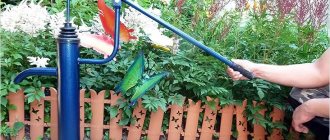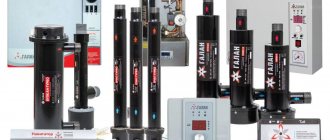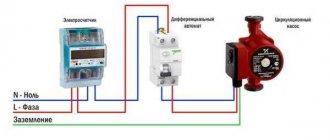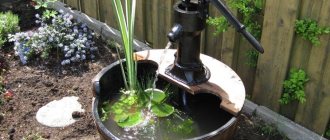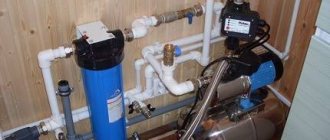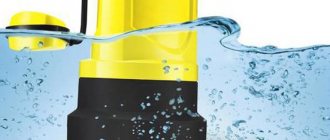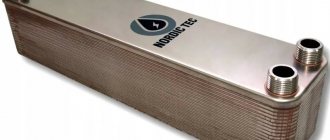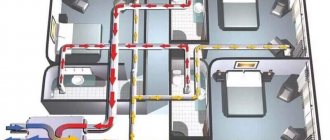The house should always be cozy, and one of the factors that ensures comfort is hot water supply.
DHW - hot water supply systems are designed to heat cold water coming from cold water supply pipes (CWS). Today, depending on the method of heating, there are two hot water supply systems:
- system with flow-through heater;
- storage system.
How to connect
To properly connect the pump to the hot water supply circuit, you must strictly follow the operating instructions provided by the manufacturer.
If there are protection systems provided by the manufacturer, their installation is mandatory. Connection is carried out in the following sequence:
- Selection of installation location. It is better to mount the pump in a separate pocket. This installation method will allow you to exclude it from the system if necessary. This may be needed for preventative measures or repairs.
- Stopping the water supply and draining the liquid from the circuit. Carrying out work if there is water in the system is prohibited. This may lead to flooding of the room.
- Removing part of the pipeline. Cutting metal pipes is carried out with an angle grinder or other tools. For plastic pipelines, specialized scissors are used. They make an even cut, which has a positive effect on the quality of soldering.
- Installation of threaded connections and pump installation.
- Connection to a household electrical network. The device must be connected to the electrical network in strict accordance with the operating instructions.
- Start-up and commissioning of the unit.
First start
Before turning on the pump, it is necessary to exclude the presence of air in the system. To do this, water pressure is pumped into the supply pipe until liquid flows from the return pipe. Starting the pump without water in the system is not recommended. This can lead to rapid failure of the device.
Pump unit and piping
They are interconnected: the layout of the circuit also depends on the parameters of the supercharger. So, for example, with indirect heating, the return pipe can be connected to an additional, third outlet; otherwise, the reverse should be applied to the tee located on the cold water supply pipe, and this implies the installation of a more powerful pump.
If the circuit for connecting hot water with circulation is implemented with a standard heating element with a pair of taps, a safety group is installed, that is, one ball valve for insertion into the “cold” line and a second one for the return flow of the liquid in the cycle loop. As a result, the ambient temperature decreases only when the fence is opened, and the boiler functions as efficiently as possible.
Attention, you need to install a special pump with 1/2 or 1/4 inch threaded pipes, that is, the same size as household communications. The power of such a supercharger will be sufficient, but not high, so it will not create excessive pressure that could cause a line rupture. Leading pump manufacturing companies, such as Grundfos or Wilo, must take this point into account.
Features of the device
A circulation (recirculation) unit for hot water supply is a device that ensures the movement of water in pipes. In addition, the equipment allows you to increase the pressure in the main pipeline to the required level (the pressure should usually be 1 kgf/cm² higher than the nominal one). Thanks to this device, you can get hot water from the tap at the same set temperature on different floors of the house.
However, in addition to this, the device must provide the specified pressure even during instant disassembly during peak hours. Simply put, when several hot water taps are open simultaneously, the pressure and temperature of the liquid should be the same everywhere. Depending on the performance and design features of the pumping equipment, certain conditions are met, as well as automatic start and stop of the unit.
Pumping equipment for hot water supply meets all standards. When operating during the day, the noise from the unit does not exceed 55 dB, and at night – 40 dB.
BC 1xBet has released an application, now you can officially download 1xBet on Android by clicking on the active link for free and without any registration.
Advantages of a hot water supply system with circulation and its scope
The practical advantages are obvious:
- the stream is at least well warm immediately after opening the tap;
- It’s easy to adjust the temperature by turning the valve and adding a little cold water;
- there is no overspending - precious liters of liquid do not pour into the drain, because you do not wait for it to heat up;
- with constant use there are no traffic jams or clogging of pipes, and if they appear, they are immediately noticeable;
- a large number of end consumers are seamlessly integrated within one solution;
- it can be implemented on the basis of any heater - storage, indirect heating boiler or double-circuit boiler.
Hence the scope of application is clear. Such systems are relevant for one- and multi-story buildings, in which water treatment equipment is installed in a technical room, away from the inhabited rooms, and/or there are several bathrooms and many intake points. They are in demand at facilities with long communication lines and help reduce fluid losses and increase the efficiency of its heating and use.
Attention, this is a global solution, and therefore its implementation (regardless of the topology) is possible at the construction stage or at least a major renovation. It is futile to modernize an existing and standard plumbing complex - too much money will be required, it is cheaper and easier to implement everything from scratch.
1.5 m3/h For process water
1.5 m3/h For process water
MBFT-75 Membrane for 75GPD
Recommendations for selection
First of all, you need to decide how much water you will regularly pump out, as well as to what height and horizontal extent to transfer.
IMPORTANT POINT! If a pump can pump out 3,000 liters of water in 1 hour, this does not mean that it will always provide this indicator, regardless of the conditions. Raising water by 1 meter, the pump simultaneously loses about 10% of its performance. At 2 meters - respectively, 20%
This is very important to consider when choosing equipment
Operating temperatures also matter. Typically, the operating range of classic models is from +4°C to +40°C. The submersible drainage pump is cooled by transferring heat to water, so it cannot operate idle or in air. A number of modern modifications have special floats that automatically turn off the power when there is no water supply. Specialized models can work with hot water from +60°C to +95°C. Such units are rarely used.
As for power, for most household models it varies from 400 to 1000 W. For personal use this is quite enough.
Also, when purchasing a submersible drainage pump, you should pay attention to the housing material. Stainless steel is the best option
It is better if the impeller is also made of metal.
Possible problems
What problems may you encounter:
With instantaneous water heater
Each chosen method of providing a home with hot water has its own weaknesses.
Electric flow heaters often fail due to burnout of heating elements, which become covered with scale and cannot withstand the load.
The same applies to the heat exchanger - poor water quality clogs the coil or honeycomb, which leads to excess pressure, and possibly even rupture and leakage of the equipment.
Therefore, maintenance consists of organizing proper filtration of the hot water supply, replacing heating elements and ensuring correct connection from an electrical point of view.
High-power electrical appliances must be equipped with individual electrical protective equipment. As for geysers and boilers, they need periodic cleaning of excess combustion products.
With storage water heater
The main problems remain the same - the performance of the heating elements, the quality of the incoming water and electrical safety.
It is electrical safety that many users neglect, not realizing that this is not only protection against electric shock, but protection of the most expensive equipment.
All models of storage heating tanks are made of metal, which means that without proper grounding, they are subject to accelerated corrosion. If the tank leaks, then in most cases such equipment cannot be repaired
This is why it is so important to check the ground circuit
As for heating elements, in these models they are even more susceptible to burnout than in flow-through ones.
Everything you need to know about hot water is presented in this section of the site.
Control method
It is quite acceptable to constantly maintain the circulation of hot water in the pipes, but this is uneconomical and unjustified. Hot water is not used constantly. At night, while all the residents are sleeping, it is useless to keep the water in the pipes hot, the same applies to the time when everyone is at work or school.
If the pipes are laid out correctly, then thermal insulation is required, so that once hot water gets into the pipes, it does not cool down instantly. Therefore, there is no need to constantly pump water from the boiler into the pipes and back; periodic operation of the pump is sufficient, which reduces the load on it and the hot water system as a whole. There is no need to talk about saving electricity, since the consumption of the recirculation pump is low.
Two main control methods are used:
- according to temperature sensor readings;
- according to a timer (schedule).
Both options are in demand, although they differ significantly in their operating principles.
By temperature sensor
Grundfos UP 15-14 BT 80
In this case, the pump control unit relies on the readings of a temperature sensor immersed in water inside the circuit pipes. The pump resumes operation as soon as the water has cooled to a certain threshold temperature. This approach significantly reduces the load on the equipment and constantly keeps the water in the pipes heated. In addition, the safety of the hot water supply increases. Having set a sufficiently high response threshold, water is pumped more often through the boiler, where it is additionally heated and disinfected.
By timer
Grundfos UP 15-14 BU
The control unit alternately turns the pump on and off based on the time delays set in the settings. Knowing exactly the parameters of the hot water system, the length of the pipes and their internal volume, thermal insulation and average heat loss, you can select the optimal time during which the water will not have time to cool down. The pump is turned on by a timer signal and pumps all the water. In this case, the duration of operation is also calculated based on the volume of pipes and pump performance.
Another advantage of the timer is the ability to schedule the operation of the recirculation pump for a day or even a week. It is in this case that downtime when hot water is not used is taken into account.
Principle of operation
A recirculation pump is not at all necessary, but it significantly increases comfort and even the quality of hot water. Its main task is to pump water through a pipeline in a closed loop from the boiler to the intake points and back. For this purpose, devices with low productivity, low noise and low energy consumption are specially developed. The main requirement for pumps is resistance to high temperatures, stable operation provided that the water is heated to 65°C.
Taken together, recirculation pumps for hot water are still different from pumps for heating. The latter are designed for temperatures up to 90°C and with significantly higher productivity. Interchangeability is irrelevant in this case. If desired, the heating pump can be used in DHW recirculation, but the pump cannot be used the other way around.
A circulation pump is especially in demand in houses with an area of more than 200 square meters, where the boiler is located in a separate room or basement, and there are several water intake points located throughout the house. You will have to wait a long time for cold water to drain from the pipes, which significantly increases consumption. If the water in the boiler heats up to 65-80°C, then almost all pathogenic bacteria die, but in the pipes where the water cools, they are able to actively multiply.
Regular pumping of water through pipes eliminates these problems in the bud. However, due to heat loss in the pipes, the load on the boiler or water heater increases, so the installation of a recirculation pump has a lesser impact on savings and is primarily responsible for the comfort of residents.
To use a recirculation pump, the DHW distribution throughout the house must be carried out in the form of a closed circuit connected to the boiler. All water intake points are already connected from it. If you take water from the top of the boiler, then this will be considered the beginning of the circuit, then the pump is installed at the second entrance to the boiler, located in the lower part of the storage tank at the same level as the entrance to the cold tap water supply.
The circulation pump must be installed together with a check valve, which will prevent the reverse flow of water in the circuit, because in this case only cold water will flow through the pipes, tied to the bottom of the boiler and the inlet water supply.
Characteristics
The list of main characteristics of circulation pumps:
- productivity, m3/hour (liter/min);
- pressure created, meters or Pa;
- power consumption, W;
- control method (by timer or temperature sensor).
The recirculation pump requires little power and performance. It is necessary to pump water only in tubes with a small internal volume, and at low speed. A device with a capacity of only 0.2-0.6 cubic meters per hour is sufficient to constantly maintain the water temperature in pipes up to 40-50 meters long.
Pump consumption is also low and ranges from 5 to 20 W. This is enough for stable operation and completion of the assigned task.
It is more important to select the correct pressure generated by the pump. More often, in a house or, especially, an apartment, the wiring is carried out one floor at a time, then a pressure equivalent to 0.5-0.8 meters of water column is sufficient. However, if it is necessary to ensure trouble-free circulation of water in a house with several floors, then the pump must cope with the rise of water to a given height, and with a margin. Pump performance directly depends on the actual installed load.
Design
Centrifugal pumps are used to circulate water. The main elements in them are the shell housing, the impeller and the engine. Water is supplied to the center of the impeller. The engine spins it, and under the influence of centripetal force, water moves with pressure along the outer edge of the shell to the outlet pipe.
For a recirculation pump, the advantages are noiselessness and small dimensions. Therefore, small pumps are used mainly with a wet rotor type. The rotor is the internal moving part of the engine, mounted on the same shaft as the impeller. Under the influence of an alternating magnetic field from the stator coil, the rotor acquires rotational motion.
The wet rotor is completely immersed in the pumped medium. Water acts as a heat sink and at the same time as a lubricant for the support bearings. The presence of water around the moving parts of the engine reduces noise and vibration during pump operation.
Varieties
The recirculation pump for domestic hot water systems can be of two types:
- reverse (installed on the return water supply pipeline);
- supply (attached to the pipes through which hot water flows from the heater).
Based on design differences, all pumps for hot water supply systems are divided into two types:
- Devices with a “wet” rotor. A recirculation pump of this type is distinguished by the fact that its pressure part (impellers and rotor) is located in the pumped liquid. In this case, hot water acts as a lubricant and cooling medium. In this regard, this type of device is characterized by long-lasting and quiet operation. In addition, the “wet” device for domestic hot water does not require maintenance and has a reasonable price. Among the disadvantages of this type of pumping equipment, it is worth listing the low efficiency (40-45%) and restrictions when installing the unit (the device can only be mounted in a horizontal position). That is why these units are purchased by owners of small houses or cottages to organize household heating and water supply systems. These devices can raise the pressure in the system to 1.5-3 atm.
- Units with a “dry” rotor. In recirculation pumps with a dry rotor, the power unit is separated from the pumped medium. Since the rotor of the device constantly remains dry, it is necessary to solve the problems of cooling and lubrication of the engine. Periodic maintenance is performed to lubricate the unit, and the engine is cooled by a built-in fan. That is why “dry” parting for hot water supply is more expensive both in purchase and in maintenance. However, the productivity of such units is two times higher than that of “wet” pumps, and can be 70%. The devices provide pressure increase up to 5-10 atm. The disadvantage is the high cost and increased noise level during operation.
Depending on the ability to switch speeds, the following models of circulation pumps are distinguished:
- multi-speed - these units allow you to switch the operating algorithm. These are more expensive devices used for heating and hot water systems in large houses;
- single-speed are models with reduced performance, suitable for domestic use. They easily fit into the system and work independently.
In addition, according to their design characteristics, single and paired devices for recirculation are distinguished. Both of these types of pumping equipment belong to the group of pumps with a “wet” rotor. Twin units are used when the power of a single pump is not enough.
A single unit has one motor and impeller. Twin models have two motors, which provide higher pressure. In addition, in these devices, each engine can replace its counterpart in the event of its breakdown. As a rule, industrial circulation units come with two motors.
Installation diagrams
Depending on the number of connection points and the length of the pipes, the method of connecting the circulation pump and pipe routing is selected:
- serial connection with one circuit;
- parallel connection with the collector.
In the first case, all water intake points are connected in series and in one circuit. This is beneficial if you can easily combine the bathrooms and kitchen with one water pipe without unnecessary material costs and a fairly short route. There is only one feature that concerns the pressure pump rather than the circulation pump. If several water intake points are open at the same time, the pressure in each of them will be divided equally. Alternatively, this can be solved by installing a gearbox on each tap and choosing a more powerful pump.
The simplest installation diagram for a recirculation pump
Parallel connection solves the problem with pressure and water distribution using a manifold group and compact placement of gearboxes. In this case, recirculation pumps must be installed in each individual circuit or one more efficient pump must be selected for all groups at once. Such wiring is necessary if there are several bathrooms in the house, spaced far from each other and from the kitchen, or when, with a serial connection, the total length of the route becomes too long.
Adviсe
Before you start looking for pumping equipment, you need to correctly calculate the device parameters. Only after this can you decide on a purchase and invest wisely. Such data includes the workload of the water supply system, as well as sufficient flow strength. An important point is to take into account the number of taps that can be turned on simultaneously. It is necessary to create the same pressure of the circulation pump so that the pressure remains constant everywhere.
If we talk about the average water consumption at one point, it is about one hundred and eighty liters per hour. If a house or apartment has two bathrooms and a kitchen where taps are located, the best choice would be to install a device with a throughput capacity of at least 0.7 cubic meters per hour. We must not forget about the hydraulic resistance of the overall system. Pressure and pressure are affected by the length and height of the pipeline, so these indicators also need to be clarified. A water column of 0.6 meters uses 10 linear meters of contour. The manufacturer always adds technical documentation to each model and type of pumping equipment, so it is worth studying all the indicators and descriptions.
Thanks to such calculations, it is possible to obtain the average heat consumption of hot liquid through a circulation pump, which will help you quickly make a choice and facilitate the purchase. Of course, an industrial-type device is suitable for pumping water at a large enterprise, but slightly different models are suitable for a home.
Today, calculations can be made online thanks to electronic calculators, where the corresponding indicators are entered, which speeds up the solution of the problem. If a pump is selected for an apartment building or a cottage with a large area, such calculations are carried out only by qualified specialists from design and installation organizations, since they are responsible for the performance of the entire system.
To complete the installation you will need to complete the following steps:
- the installation location of the circulation device is selected. The module must be installed on the return line, which will prevent air from entering, which in turn will lead to a decrease in the functionality of the entire system;
- a check valve must be installed between the pump and the storage tank;
- shut-off valves are installed before and after the station, their number depends on needs;
- A UPS is used for connection. As soon as the power is turned off, it will ensure that the device operates in autonomous mode. The duration of its operation ranges from several hours to a day.
Of course, it is also necessary to choose an uninterruptible power supply according to certain parameters, taking into account the rules
Uniform distribution of pressure is an important task. For this purpose, special manifolds and pressure-reducing valves are used.
You cannot run the electric motor idle, which will negatively affect its performance and the device will quickly fail. After installing the pump in the DHW system, it is necessary to fill the water circuit and do a test run to check the functionality of the mechanism.
The device with a wet rotor is a simple design that does not require regular inspection or even repair, which is one of the main advantages of this equipment. The only thing you need to do is clean and replace the filter if necessary. Glanded rotor pumps require maintenance once every two years. It is necessary to replace the lubricant and clean the housing for the device to operate smoothly. If desired, you can consult with qualified specialists to make the right choice.
In the next video you will find a review of the surface circulation pump GRUNDFOS UP 15-14 B.
What you need to know about collectors?
This design ensures a uniform supply of liquid to several simultaneously switched on water taps while maintaining the required pressure. When selecting equipment, you should remember that there are manifolds for distributing cold and hot water.
To make the device body, brass or stainless steel is used; there are devices made of impact-resistant plastic that can withstand heating to temperatures of more than 100°C. Metal products are attached to pipelines using threaded bushings. To connect plastic pipelines, manifolds with compression transition elements or with special bushings (fittings) are used that allow plastic pipes to be soldered.
When selecting a collector, you should take into account the number of outputs intended for switching external equipment. Standard products provide up to 6 channels, but manufacturers allow 2-3 collector modules to be connected in series. For coupling, couplings are provided at the nodes; the method of connection depends on the design features of the collector. If switching of the additional unit is not required, the collector is closed with an end cap.
Recommendations for the buyer
Basic recommendations for selecting a collector:
- Before purchasing a collector, you should decide on the type of material of the water pipes. It is recommended to use products made of polymers (for example, cross-linked polyethylene) that are not destroyed by water and do not have threaded connections.
- During the installation process, it is necessary to provide for the installation of a tap for the side lines. There are manifold blocks with integrated valves; the installer needs to connect the pipes and the manifold itself to the central riser. Please note that if the locking mechanism is damaged, the entire manifold block will need to be replaced. When using brass or stainless steel products, the taps must be installed separately.
- A block of additional devices is installed in front of the manifold (for example, meters, filters or a check valve).
How the unit works
The principle of operation of the circulation unit is very similar to the operation of a drainage pump. If this device is installed in a heating system, it will cause movement of the coolant by capturing liquid on one side and pumping it into the pipeline on the other side
The principle of operation of the circulation unit is very similar to the operation of a drainage pump. If this device is installed in a heating system, it will cause the movement of the coolant by capturing liquid on one side and pumping it into the pipeline on the other side. All this happens due to the centrifugal force, which is formed during the rotation of the wheel with blades. During operation of the device, the pressure in the expansion tank does not change. If it is necessary to increase the coolant level in the heating system, install a booster pump. The circulation unit only helps water overcome the resistance force.
The device installation diagram looks like this:
- A circulation pump is installed on the pipeline with hot water coming from the heater.
- A bypass valve is installed on the section of the line between the pumping equipment and the heater.
- The pipeline between the bypass valve and the circulation pump is connected by a bypass to the return pipeline.
This installation scheme involves the release of coolant from the device only if the unit is filled with water. To keep the liquid in the wheel for a long time, a receiver equipped with a check valve is built at the end of the pipeline.
Circulation pumps used for domestic purposes can develop a coolant speed of up to 2 m/s, and units used in the industrial field accelerate the coolant up to 8 m/s.
It’s worth knowing: any type of circulation pump operates from the mains. This is quite economical equipment, since the motor power for large industrial pumps is 0.3 kW, and for household appliances it is only 85 W.
Common connection options
If you decide to install a single-pipe system, you will have to choose between two types:
- simple circuit without regulation;
- "Leningradka" with the ability to turn off individual radiators.
In terms of control method, the first option is clearly inferior to the second; its only advantage is its budget cost.
Installation of a simple single-pipe system of horizontal or vertical type is simple and reliable, but temperature control in the network is impossible (+)
Installing the Leningradka will cost a little more, since in addition to the pipes you need to purchase a set of shut-off valves. Using bypasses and valves, you can reduce/increase the amount of coolant supplied to the radiator.
Diagram of the Leningradka device: using shut-off valves, you can temporarily turn off individual unnecessary radiators without changing the functional qualities of the entire system as a whole (+)
"Leningradka" is recognized by professional heating engineers as the best option for a single-pipe system for a 2-story residential building.
Complete set and installation of equipment
- circulation pump;
- gas or electric boiler (power depends on the size of the house, characteristics of the coolant, etc.);
- expansion tank;
- pipes 20 mm and 25 mm;
- adapters, gaskets, plugs;
- set of radiators;
- Mayevsky cranes.
Along with steel pipes, polymer or metal-plastic pipes can be used, with the latter being preferred.
In heating circuits with closed expansion tanks, air is bled using automatic bleeders equipped with shut-off valves and floats, or Mayevsky valves supplying each radiator
First, they find a suitable place for the boiler and install it, then assemble the pipeline leading to the radiators. Tees are fixed in places of radiator branches and bypasses. The pump is installed on the return line, next to the inlet to the boiler, and connected to the power supply.
The installation location of an open expansion tank is the highest point of the system; a closed one can be mounted in any convenient place, for example, in a boiler room. Radiators are suspended from the walls using special fasteners and equipped with plugs and taps.
Where to put
It is recommended to install a circulation pump after the boiler, before the first branch, but on the supply or return pipeline it doesn’t matter. Modern units are made from materials that can withstand temperatures up to 100-115°C. There are few heating systems that work with a hotter coolant, so considerations of a more “comfortable” temperature are untenable, but if you feel safer, put it in the return line.
Can be installed in the return or direct pipeline after/before the boiler up to the first branch
There is no difference in hydraulics - the boiler, and the rest of the system; it makes absolutely no difference whether there is a pump in the supply or return branch. What matters is the correct installation, in terms of strapping, and the correct orientation of the rotor in space
Nothing else matters
There is one important point regarding the installation location. If the heating system has two separate branches - on the right and left wings of the house or on the first and second floor - it makes sense to install a separate unit on each, and not one common one - directly after the boiler. Moreover, the same rule remains on these branches: immediately after the boiler, before the first branch in this heating circuit. This will make it possible to set the required thermal conditions in each part of the house independently of the other, and also in two-story houses to save on heating. How? Due to the fact that the second floor is usually much warmer than the first floor and much less heat is required there. If there are two pumps in the branch that goes up, the speed of movement of the coolant is set much lower, and this allows you to burn less fuel, without compromising the comfort of living.
There are two types of heating systems - forced and natural circulation. Systems with forced circulation cannot work without a pump; systems with natural circulation work, but in this mode they have lower heat transfer. However, less heat is still much better than no heat at all, so in areas where electricity is often cut off, the system is designed as hydraulic (with natural circulation), and then a pump is installed into it. This gives high heating efficiency and reliability. It is clear that the installation of a circulation pump in these systems is different.
All heating systems with heated floors are forced - without a pump, the coolant will not pass through such large circuits
Forced circulation
Since a forced circulation heating system without a pump is inoperative, it is installed directly into the gap in the supply or return pipe (of your choice).
Most problems with the circulation pump arise due to the presence of mechanical impurities (sand, other abrasive particles) in the coolant. They can jam the impeller and stop the motor. Therefore, a mesh dirt filter must be placed in front of the unit.
Installing a circulation pump in a forced circulation system
It is also advisable to install ball valves on both sides. They will make it possible to replace or repair the device without draining the coolant from the system. Turn off the taps and remove the unit. Only that part of the water that was directly in this piece of the system is drained.
Natural circulation
The piping of the circulation pump in gravity systems has one significant difference - a bypass is required. This is a jumper that makes the system operational when the pump is not working. One ball shut-off valve is installed on the bypass, which is closed the entire time the pumping is running. In this mode, the system operates as forced.
Installation diagram of a circulation pump in a system with natural circulation
When the electricity goes out or the unit fails, the valve on the jumper is opened, the valve leading to the pump is closed, and the system operates as a gravity system.
Installation features
There is one important point, without which the installation of the circulation pump will require rework: it is necessary to rotate the rotor so that it is directed horizontally. The second point is the direction of flow. There is an arrow on the body indicating which direction the coolant should flow. This is how you turn the unit so that the direction of movement of the coolant is “in the direction of the arrow”.
The pump itself can be installed both horizontally and vertically, just when selecting a model, make sure that it can work in both positions. And one more thing: with a vertical arrangement, the power (pressure created) drops by about 30%. This must be taken into account when choosing a model.
Two-pipe heating
A two-pipe heating system requires connecting each radiator to pipelines that are responsible for the flow of heated coolant and the removal of coolant. The main positive aspect of this design is the ability to adjust the temperature of individual heating elements.
Vertical scheme
When implementing such a project, several wiring options are provided:
- Lower two-pipe distribution - the main heating unit, which supplies coolant to the heating elements, is located in the basement or above the floor level of the lower floor. Riser pipes in a multi-storey building are diverted from the main pipe, the presence of which ensures the flow of working fluid to the radiators. Subsequently, the cooled liquid moves in the opposite direction through the outlet pipes.
- Upper two-pipe distribution - involves supplying coolant from the main heat generator directly to the attic of the house. Passing through the heating radiators, the heated working fluid returns from the upper distribution through the corresponding risers.
In order to remove air that accumulates during operation, it is recommended to supplement the two-pipe system with a special expansion tank. Installing the tank yourself allows you to ensure high pressure levels when moving coolant, which helps to increase heating efficiency.
Horizontal scheme
This option is the most common when installing two-pipe heating.
Functionality is ensured by forced circulation of coolant. There are the following options for implementing such a scheme:
- Dead end. It is characterized by relatively low consumption of materials when installing heating. The obvious negative point here is the impressive length of the system circuit, which is laid in a wide circle from the main heating unit. Compliance with such a requirement complicates the regulation of the temperature of individual heating elements.
- Along the way. Allows you to make correction of the coolant temperature in individual radiators more convenient due to the equal length of the circulation circuits. At the same time, the implementation of such a project requires the use of a significant number of pipes.
- Ray. It assumes radial distribution of the coolant, which is accompanied by maximum consumption of consumables. An obvious advantage is the possibility of hidden installation of the pipeline system in the thickness of concrete. This allows you to maintain the visual appeal of heated rooms.
Malfunctions
What problems in the operation of the water supply system can the apartment owner eliminate on his own? Here are some of the most typical situations.
Valves leaking
Description: leakage along the stem of screw valves.
A typical leak location is shown by an arrow.
- Reason: partial wear of the oil seal or wear of the rubber O-ring.
- Solution: open the valve knob all the way. In this case, the thread on the rod will tighten the seal from below, and the leak will stop.
Crane noise
Description: when you open a hot or (less often) cold water tap, you hear a loud noise and feel the vibration of the mixer. Alternatively, your neighbors faucet could be the source of the noise.
A noisy neighbor's faucet can become a source of a lot of negative emotions.
Cause: a deformed and crushed gasket on the screw valve in the half-open position causes a continuous series of water hammers. Its valve closes the seat in the mixer body at intervals of a fraction of a second. In hot water, the pressure is usually noticeably higher, so the effect is more pronounced.
Solution:
- Shut off the water to the apartment;
- Turn out the problematic valve housing;
- Replace the gasket with a new one;
- Use scissors to remove the chamfer from the new gasket. The removed chamfer will prevent the valve from beating in a turbulent stream of water in the future.
Replacing the gasket on the screw valve
The photo shows a ceramic crane box
Cold heated towel rail
- Description: The heated towel rail in your bathroom has cooled down and is not heating up.
- Reason: if the water supply scheme of a residential apartment building uses continuous circulation of hot water, the air remaining in the jumper between the risers after water is discharged (for example, for inspection and repair of shut-off valves) is to blame.
- Solution: go up to the top floor and ask your neighbors to bleed the air from the jumper between the DHW risers and heated towel rails.
If for some reason this cannot be done, the problem can be solved from the basement:
- Shut off the DHW riser passing through your apartment, to which your connections are connected;
- Go up to the apartment and open the hot water taps all the way;
- After all the air has come out of the riser through them, close the taps and open the tap on the riser.
If a vent is installed on the riser, it can be diverted directly from the basement
Immediately after the end of the heating season, the difference between the lines of the route may be zero
Gas boilers
In houses with central heating or apartments, it is beneficial to install gas boilers. Under these conditions, they provide savings at the same level of performance. Gas boilers come in two types - with an open combustion chamber and with a closed one. This allows you to use them in an apartment without the use of additional communications, since the power is comparable to the power of a gas stove. And it does not require an additional smoke exhaust device.
Just like in a gas boiler, gas ignition is ensured by a duty wick, which burns all the time and burns gas uselessly, by electronic ignition using batteries, or by hydrodynamic ignition. It is triggered when the cold water tap is opened. The current rotates a small turbine, which ignites the gas in the burner.
Hot water recirculation
Recirculating hot water will allow you to quickly get enough hot water. If you install a water heating boiler in your home, be sure to wire it up.
Thanks to recirculation, a pipeline is created through which water constantly flows and at the same time constantly heats up without having time to cool down. Because of this system, you will be able to get water as soon as you open the tap.
To make such a system, you need to install a recirculation pump. In this case, the flow of hot water must be directed in such a way that it constantly passes through structures that require heat. By fulfilling this condition, you will get maximum boiler efficiency.
